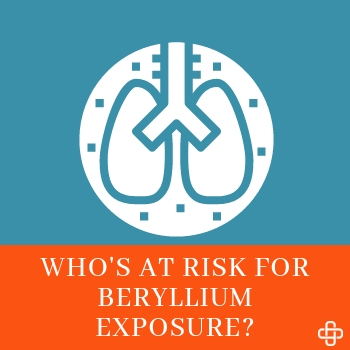 Used in everything from electronic components to aerospace materials, beryllium has the potential to put employees’ health at risk when exposed. But who specifically is at risk?
Used in everything from electronic components to aerospace materials, beryllium has the potential to put employees’ health at risk when exposed. But who specifically is at risk?
How dangerous can it be?
Let’s take a look.
Industries at Risk
Employees within various trades and industries may be exposed to inhaled beryllium or beryllium alloys, including:
- Construction and shipyard workers involved with sandblasting and industrial ceramics
- Welders
- Boilermakers, roofing installers, and sheet metal workers
- Workers in precision machine shops, metal recycling businesses, mining, tool and die manufacturing and electronics
- Machinists employed in ceramics and nuclear materials manufacturing
What’s So Dangerous About Beryllium Exposure?
When exposed, employees run the risk of developing a serious condition called chronic beryllium disease (CBD).
CBD is actually the scarring of lungs which occurs when someone inhales beryllium dust, mist or fumes and develops sensitivity to the beryllium. While the exposed worker may not initially exhibit symptoms, later progression can lead to:
- Difficulty breathing
- Persistent dry cough
- Joint pain
- Appetite loss
- Night sweats
- Fatigue
Though treatable with corticosteroids, oxygen and other means to slow disease progression, it’s important to remember that CBD is INCURABLE. If an employee develops the disease, their lives are forever changed!
Who Requires Medical Surveillance?
OSHA requires employers to offer medical surveillance to employees who meet one of the following conditions, known as triggers:
- An employee who is or who is reasonably expected to be exposed above the action level of 0.1 µg/m3 for 30 days in a year.
- An employee who shows signs or symptoms of CBD.
- An employee who has been exposed to beryllium during an emergency.
- An employee who has received a recommendation for continued medical surveillance from a physician or other licensed health care professional (PLHCP) from their most recent exam.
Once a worker meets any of the triggers described above, the employer is required under the new beryllium standards, which include the following provisions, to:
Offer medical surveillance to a worker within 30 days of meeting the criteria for trigger events.
This includes testing every two years for those who continue to meet the criteria for trigger events.
The medical examination must include:
- Medical and work history with emphasis on past and present airborne exposure to or dermal contact with beryllium, smoking history, and any history of respiratory system dysfunction
- Physical examination with emphasis on the respiratory system
- Physical examination for skin rashes
- Pulmonary function tests
- BeLPT1 (or other equivalent test)
- Any other test deemed appropriate by the physician or other licensed health care professional (PLHCP)
Get & Stay OSHA Compliant with Axiom’s Help!
OSHA’s final rule on Occupational Exposure to Beryllium is designed to strengthen worker protection against exposure.
Let us help you protect employee lives with our comprehensive beryllium exams today.
Give us a call at (877) 502-9466.

Holly is an ER nurse by trade, but loves content marketing. She was born outside the box and believes everything is better with “sprinkles and sparkles”. She is passionate about impacting lives and uses marketing as her platform for sharing practical solutions to address real life occupational health challenges.
Find out more about our Injury Case Management services or our Occupational Health Programs.










